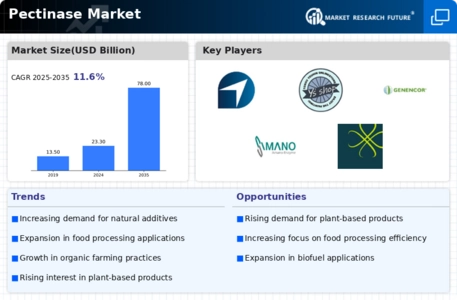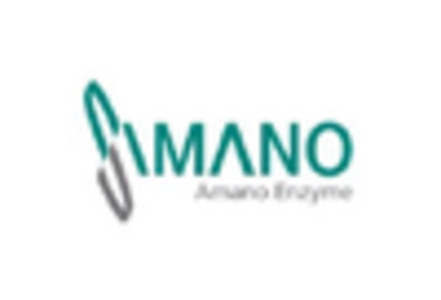-
EXECUTIVE SUMMARY
-
MARKET INTRODUCTION
-
Definition
-
Scope of the Study
- Research Objective
- Assumptions
- Limitations
-
RESEARCH METHODOLOGY
-
Overview
-
Data Mining
-
Secondary Research
-
Primary Research
- Primary Interviews
- Breakdown of Primary Respondents
-
and Information Gathering Process
-
Forecasting Modality
-
Market Size Estimation
- Bottom-Up Approach
- Top-Down Approach
-
Data Triangulation
-
Validation
-
MARKET DYNAMICS
-
Overview
-
Drivers
-
Restraints
-
Opportunities
-
MARKET FACTOR ANALYSIS
-
Value Chain Analysis
-
Porter’s Five Forces Analysis
- Bargaining Power
- Threat of New Entrants
- Threat of Substitutes
- Intensity of Rivalry
-
of Suppliers
-
5.2.2.
-
Bargaining Power of Buyers
-
COVID-19 Impact Analysis
- Market Impact Analysis
- Regional Impact
- Opportunity and
-
Threat Analysis
-
6.
-
GLOBAL PECTINASE MARKET, BY TYPE
-
Overview
-
Protopectinases
-
Polygalacturonases
-
Pectin lyases
-
Pectinesterase
-
GLOBAL PECTINASE MARKET, BY END-USER
-
Overview
-
Food & Beverages
-
Textile
-
Aquaculture
-
Others
-
GLOBAL PECTINASE MARKET,
-
BY REGION
-
8.1.
-
Overview
-
8.2.
-
North America
-
8.2.1.
-
U.S.
-
8.2.2.
-
Canada
-
8.3.
-
Europe
-
8.3.1.
-
Germany
-
8.3.2.
-
France
-
8.3.3.
-
U.K
-
8.3.4.
-
Italy
-
8.3.5.
-
Spain
-
8.3.6.
-
Rest of Europe
-
8.4.
-
Asia-Pacific
-
8.4.1.
-
China
-
8.4.2.
-
India
-
8.4.3.
-
Japan
-
8.4.4.
-
South Korea
-
8.4.5.
-
Australia
-
8.4.6.
-
Rest of Asia-Pacific
-
8.5.
-
Rest of the World
-
8.5.1.
-
Middle East
-
8.5.2.
-
Africa
-
8.5.3.
-
Latin America
-
9.
-
COMPETITIVE LANDSCAPE
-
9.1.
-
Overview
-
9.2.
-
Competitive Analysis
-
9.3.
-
Market Share Analysis
-
9.4.
-
Major Growth Strategy in the Global Pectinase Market,
-
Competitive Benchmarking
-
Leading Players in Terms of Number of Developments
-
in the Global Pectinase Market,
-
Key developments and Growth Strategies
- New TYPE Launch/END-USER Deployment
- Merger & Acquisitions
- Joint Ventures
-
Major Players Financial
- Major Players R&D Expenditure. 2022
-
Matrix
-
9.8.1.
-
Sales & Operating Income, 2022
-
COMPANY PROFILES
-
Challenge Group
- Company Overview
- Financial Overview
- TYPE Offered
- Key Developments
- SWOT Analysis
- Key Strategies
-
AB Enzymes
- Company Overview
- Financial Overview
- TYPE Offered
- Key Developments
- SWOT Analysis
- Key Strategies
-
Jinyuan Biochemical
-
Co Ltd
-
10.3.1.
-
Company Overview
-
10.3.2.
-
Financial Overview
-
10.3.3.
-
TYPE Offered
-
10.3.4.
-
Key Developments
-
10.3.5.
-
SWOT Analysis
-
10.3.6.
-
Key Strategies
-
10.4.
-
Sukahan Bio-Technology
-
10.4.1.
-
Company Overview
-
10.4.2.
-
Financial Overview
-
10.4.3.
-
TYPE Offered
-
10.4.4.
-
Key Developments
-
10.4.5.
-
SWOT Analysis
-
10.4.6.
-
Key Strategies
-
10.5.
-
Sunson
-
10.5.1.
-
Company Overview
-
10.5.2.
-
Financial Overview
-
10.5.3.
-
TYPE Offered
-
10.5.4.
-
Key Developments
-
10.5.5.
-
SWOT Analysis
-
10.5.6.
-
Key Strategies
-
10.6.
-
Shandong Longda
-
10.6.1.
-
Company Overview
-
10.6.2.
-
Financial Overview
-
10.6.3.
-
TYPE Offered
-
10.6.4.
-
Key Developments
-
10.6.5.
-
SWOT Analysis
-
10.6.6.
-
Key Strategies
-
10.7.
-
Verenium (BASF)
-
10.7.1.
-
Company Overview
-
10.7.2.
-
Financial Overview
-
10.7.3.
-
TYPE Offered
-
10.7.4.
-
Key Developments
-
10.7.5.
-
SWOT Analysis
-
10.7.6.
-
Key Strategies
-
10.8.
-
YSSH
-
10.8.1.
-
Company Overview
-
10.8.2.
-
Financial Overview
-
10.8.3.
-
TYPE Offered
-
10.8.4.
-
Key Developments
-
10.8.5.
-
SWOT Analysis
-
10.8.6.
-
Key Strategies
-
10.9.
-
AB Enzymes
-
10.9.1.
-
Company Overview
-
10.9.2.
-
Financial Overview
-
10.9.3.
-
TYPE Offered
-
10.9.4.
-
Key Developments
-
10.9.5.
-
SWOT Analysis
-
10.9.6.
-
Key Strategies
-
10.10.
-
Genencor
-
10.10.1.
-
Company Overview
-
10.10.2.
-
Financial Overview
-
10.10.3.
-
TYPE Offered
-
10.10.4.
-
Key Developments
-
10.10.5.
-
SWOT Analysis
-
10.10.6.
-
Key Strategies
-
10.11.
-
Koninklijke DSM N.V
-
10.11.1.
-
Company Overview
-
10.11.2.
-
Financial Overview
-
10.11.3.
-
TYPE Offered
-
10.11.4.
-
Key Developments
-
10.11.5.
-
SWOT Analysis
-
10.11.6.
-
Key Strategies
-
10.12.
-
Amano Enzyme
-
10.12.1.
-
Company Overview
-
10.12.2.
-
Financial Overview
-
10.12.3.
-
TYPE Offered
-
10.12.4.
-
Key Developments
-
10.12.5.
-
SWOT Analysis
-
10.12.6.
-
Key Strategies
-
10.13.
-
Youtell
-
10.13.1.
-
Company Overview
-
10.13.2.
-
Financial Overview
-
10.13.3.
-
TYPE Offered
-
10.13.4.
-
Key Developments
-
10.13.5.
-
SWOT Analysis
-
10.13.6.
-
Key Strategies
-
10.14.
-
Novozymes
-
10.14.1.
-
Company Overview
-
10.14.2.
-
Financial Overview
-
10.14.3.
-
TYPE Offered
-
10.14.4.
-
Key Developments
-
10.14.5.
-
SWOT Analysis
-
10.14.6.
-
Key Strategies
-
11.
-
APPENDIX
-
11.1.
-
References
-
11.2.
-
Related Reports
-
-
LIST OF TABLES
-
GLOBAL PECTINASE
-
MARKET, SYNOPSIS, 2018-2032
-
GLOBAL PECTINASE MARKET, ESTIMATES & FORECAST, 2018-2032
-
(USD BILLION)
-
TABLE
-
GLOBAL PECTINASE MARKET, BY TYPE, 2018-2032 (USD BILLION)
-
GLOBAL PECTINASE MARKET, BY END-USER, 2018-2032
-
(USD BILLION)
-
TABLE
-
NORTH AMERICA PECTINASE MARKET, BY TYPE, 2018-2032 (USD BILLION)
-
NORTH AMERICA PECTINASE
-
MARKET, BY END-USER, 2018-2032 (USD BILLION)
-
NORTH AMERICA PECTINASE MARKET, BY COUNTRY,
-
U.S. PECTINASE MARKET, BY TYPE, 2018-2032 (USD BILLION)
-
U.S. PECTINASE
-
MARKET, BY END-USER, 2018-2032 (USD BILLION)
-
CANADA PECTINASE MARKET, BY TYPE, 2018-2032
-
(USD BILLION)
-
TABLE
-
CANADA PECTINASE MARKET, BY END-USER, 2018-2032 (USD BILLION)
-
EUROPE PECTINASE MARKET,
-
BY TYPE, 2018-2032 (USD BILLION)
-
EUROPE PECTINASE MARKET, BY END-USER, 2018-2032 (USD BILLION)
-
EUROPE PECTINASE
-
MARKET, BY COUNTRY, 2018-2032 (USD BILLION)
-
GERMANY PECTINASE MARKET, BY TYPE, 2018-2032
-
(USD BILLION)
-
TABLE
-
GERMANY PECTINASE MARKET, BY END-USER, 2018-2032 (USD BILLION)
-
FRANCE PECTINASE MARKET,
-
BY TYPE, 2018-2032 (USD BILLION)
-
FRANCE PECTINASE MARKET, BY END-USER, 2018-2032 (USD BILLION)
-
ITALY PECTINASE
-
MARKET, BY TYPE, 2018-2032 (USD BILLION)
-
ITALY PECTINASE MARKET, BY END-USER, 2018-2032
-
(USD BILLION)
-
TABLE
-
SPAIN PECTINASE MARKET, BY TYPE, 2018-2032 (USD BILLION)
-
SPAIN PECTINASE MARKET, BY END-USER, 2018-2032
-
(USD BILLION)
-
TABLE
-
U.K PECTINASE MARKET, BY TYPE, 2018-2032 (USD BILLION)
-
U.K PECTINASE MARKET, BY END-USER, 2018-2032
-
(USD BILLION)
-
TABLE
-
REST OF EUROPE PECTINASE MARKET, BY TYPE, 2018-2032 (USD BILLION)
-
REST OF EUROPE PECTINASE
-
MARKET, BY END-USER, 2018-2032 (USD BILLION)
-
ASIA PACIFIC PECTINASE MARKET, BY TYPE,
-
ASIA PACIFIC PECTINASE MARKET, BY END-USER, 2018-2032 (USD
-
BILLION)
-
TABLE
-
ASIA PACIFIC PECTINASE MARKET, BY COUNTRY, 2018-2032 (USD BILLION)
-
JAPAN PECTINASE
-
MARKET, BY TYPE, 2018-2032 (USD BILLION)
-
JAPAN PECTINASE MARKET, BY END-USER, 2018-2032
-
(USD BILLION)
-
TABLE
-
CHINA PECTINASE MARKET, BY TYPE, 2018-2032 (USD BILLION)
-
CHINA PECTINASE MARKET, BY END-USER, 2018-2032
-
(USD BILLION)
-
TABLE
-
INDIA PECTINASE MARKET, BY TYPE, 2018-2032 (USD BILLION)
-
INDIA PECTINASE MARKET, BY END-USER, 2018-2032
-
(USD BILLION)
-
TABLE
-
AUSTRALIA PECTINASE MARKET, BY TYPE, 2018-2032 (USD BILLION)
-
AUSTRALIA PECTINASE
-
MARKET, BY END-USER, 2018-2032 (USD BILLION)
-
SOUTH KOREA PECTINASE MARKET, BY TYPE, 2018-2032
-
(USD BILLION)
-
TABLE
-
SOUTH KOREA PECTINASE MARKET, BY END-USER, 2018-2032 (USD BILLION)
-
REST OF ASIA-PACIFIC
-
PECTINASE MARKET, BY TYPE, 2018-2032 (USD BILLION)
-
REST OF ASIA-PACIFIC PECTINASE MARKET, BY
-
END-USER, 2018-2032 (USD BILLION)
-
REST OF WORLD PECTINASE MARKET, BY TYPE, 2018-2032 (USD BILLION)
-
REST OF WORLD
-
PECTINASE MARKET, BY END-USER, 2018-2032 (USD BILLION)
-
REST OF WORLD PECTINASE MARKET, BY COUNTRY,
-
MIDDLE EAST PECTINASE MARKET, BY TYPE, 2018-2032 (USD BILLION)
-
MIDDLE EAST
-
PECTINASE MARKET, BY END-USER, 2018-2032 (USD BILLION)
-
AFRICA PECTINASE MARKET, BY TYPE, 2018-2032
-
(USD BILLION)
-
TABLE
-
AFRICA PECTINASE MARKET, BY END-USER, 2018-2032 (USD BILLION)
-
LATIN AMERICA PECTINASE
-
MARKET, BY TYPE, 2018-2032 (USD BILLION)
-
LATIN AMERICA PECTINASE MARKET, BY END-USER, 2018-2032
-
(USD BILLION)
-
-
LIST OF FIGURES
-
RESEARCH PROCESS
-
MARKET STRUCTURE
-
FOR THE GLOBAL PECTINASE MARKET
-
MARKET DYNAMICS FOR THE GLOBAL PECTINASE MARKET
-
GLOBAL PECTINASE
-
MARKET, SHARE (%), BY TYPE, 2022
-
GLOBAL PECTINASE MARKET, SHARE (%), BY END-USER, 2022
-
GLOBAL PECTINASE
-
MARKET, SHARE (%), BY REGION, 2022
-
NORTH AMERICA: PECTINASE MARKET, SHARE (%), BY
-
REGION, 2022
-
FIGURE
-
EUROPE: PECTINASE MARKET, SHARE (%), BY REGION, 2022
-
ASIA-PACIFIC: PECTINASE MARKET, SHARE (%),
-
BY REGION, 2022
-
FIGURE
-
REST OF THE WORLD: PECTINASE MARKET, SHARE (%), BY REGION, 2022
-
GLOBAL PECTINASE MARKET:
-
COMPANY SHARE ANALYSIS, 2022 (%)
-
CHALLENGE GROUP: FINANCIAL OVERVIEW SNAPSHOT
-
CHALLENGE GROUP: SWOT
-
ANALYSIS
-
FIGURE
-
AB ENZYMES: FINANCIAL OVERVIEW SNAPSHOT
-
AB ENZYMES: SWOT ANALYSIS
-
JINYUAN BIOCHEMICAL
-
CO LTD: FINANCIAL OVERVIEW SNAPSHOT
-
JINYUAN BIOCHEMICAL CO LTD: SWOT ANALYSIS
-
SUKAHAN BIO-TECHNOLOGY:
-
FINANCIAL OVERVIEW SNAPSHOT
-
SUKAHAN BIO-TECHNOLOGY: SWOT ANALYSIS
-
SUNSON.: FINANCIAL OVERVIEW SNAPSHOT
-
SUNSON.: SWOT
-
ANALYSIS
-
FIGURE
-
SHANDONG LONGDA: FINANCIAL OVERVIEW SNAPSHOT
-
SHANDONG LONGDA: SWOT ANALYSIS
-
VERENIUM (BASF):
-
FINANCIAL OVERVIEW SNAPSHOT
-
VERENIUM (BASF): SWOT ANALYSIS
-
YSSH: FINANCIAL OVERVIEW SNAPSHOT
-
YSSH: SWOT
-
ANALYSIS
-
FIGURE
-
AB ENZYMES: FINANCIAL OVERVIEW SNAPSHOT
-
AB ENZYMES: SWOT ANALYSIS
-
GENENCOR: FINANCIAL
-
OVERVIEW SNAPSHOT
-
FIGURE
-
GENENCOR: SWOT ANALYSIS
-
KONINKLIJKE DSM N.V: FINANCIAL OVERVIEW SNAPSHOT
-
KONINKLIJKE
-
DSM N.V: SWOT ANALYSIS
-
AMANO ENZYME: FINANCIAL OVERVIEW SNAPSHOT
-
AMANO ENZYME: SWOT
-
ANALYSIS
-
FIGURE
-
YOUTELL: FINANCIAL OVERVIEW SNAPSHOT
-
YOUTELL: SWOT ANALYSIS
-
NOVOZYMES: FINANCIAL OVERVIEW SNAPSHOT
-
FIGURE 39
-
NOVOZYMES: SWOT ANALYSIS









Leave a Comment